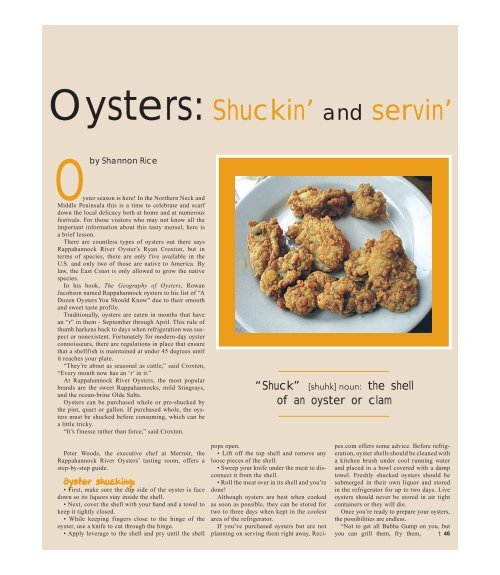Fall RIVAH 2011 - The Rappahannock Record
Fall RIVAH 2011 - The Rappahannock Record
Fall RIVAH 2011 - The Rappahannock Record
You also want an ePaper? Increase the reach of your titles
YUMPU automatically turns print PDFs into web optimized ePapers that Google loves.
Oysters: Shuckin’ and servin’<br />
Oby Shannon Rice<br />
yster season is here! In the Northern Neck and<br />
Middle Peninsula this is a time to celebrate and scarf<br />
down the local delicacy both at home and at numerous<br />
festivals. For those visitors who may not know all the<br />
important information about this tasty morsel, here is<br />
a brief lesson.<br />
<strong>The</strong>re are countless types of oysters out there says<br />
<strong>Rappahannock</strong> River Oyster’s Ryan Croxton, but in<br />
terms of species, there are only five available in the<br />
U.S. and only two of those are native to America. By<br />
law, the East Coast is only allowed to grow the native<br />
species.<br />
In his book, <strong>The</strong> Geography of Oysters, Rowan<br />
Jacobson named <strong>Rappahannock</strong> oysters to his list of “A<br />
Dozen Oysters You Should Know” due to their smooth<br />
and sweet taste profile.<br />
Traditionally, oysters are eaten in months that have<br />
an “r” in them - September through April. This rule of<br />
thumb harkens back to days when refrigeration was suspect<br />
or nonexistent. Fortunately for modern-day oyster<br />
connoisseurs, there are regulations in place that ensure<br />
that a shellfish is maintained at under 45 degrees until<br />
it reaches your plate.<br />
“<strong>The</strong>y’re about as seasonal as cattle,” said Croxton,<br />
“Every month now has an ‘r’ in it.”<br />
At <strong>Rappahannock</strong> River Oysters, the most popular<br />
brands are the sweet <strong>Rappahannock</strong>s, mild Stingrays,<br />
and the ocean-brine Olde Salts.<br />
Oysters can be purchased whole or pre-shucked by<br />
the pint, quart or gallon. If purchased whole, the oysters<br />
must be shucked before consuming, which can be<br />
a little tricky.<br />
“It’s finesse rather than force,” said Croxton.<br />
“Shuck” [shuhk] noun: the shell<br />
of an oyster or clam<br />
Peter Woods, the executive chef at Merroir, the<br />
<strong>Rappahannock</strong> River Oysters’ tasting room, offers a<br />
step-by-step guide.<br />
Oyster shucking:<br />
<br />
down so its liquors stay inside the shell.<br />
<br />
keep it tightly closed.<br />
<br />
oyster, use a knife to cut through the hinge.<br />
<br />
pops open.<br />
<br />
loose pieces of the shell.<br />
<br />
connect it from the shell.<br />
<br />
done!<br />
Although oysters are best when cooked<br />
as soon as possible, they can be stored for<br />
two to three days when kept in the coolest<br />
area of the refrigerator.<br />
If you’ve purchased oysters but are not<br />
planning on serving them right away, Recipes.com<br />
offers some advice. Before refrigeration,<br />
oyster shells should be cleaned with<br />
a kitchen brush under cool running water<br />
and placed in a bowl covered with a damp<br />
towel. Freshly shucked oysters should be<br />
submerged in their own liquor and stored<br />
<br />
oysters should never be stored in air tight<br />
containers or they will die.<br />
Once you’re ready to prepare your oysters,<br />
the possibilities are endless.<br />
“Not to get all Bubba Gump on you, but<br />
you can grill them, fry them, t46












